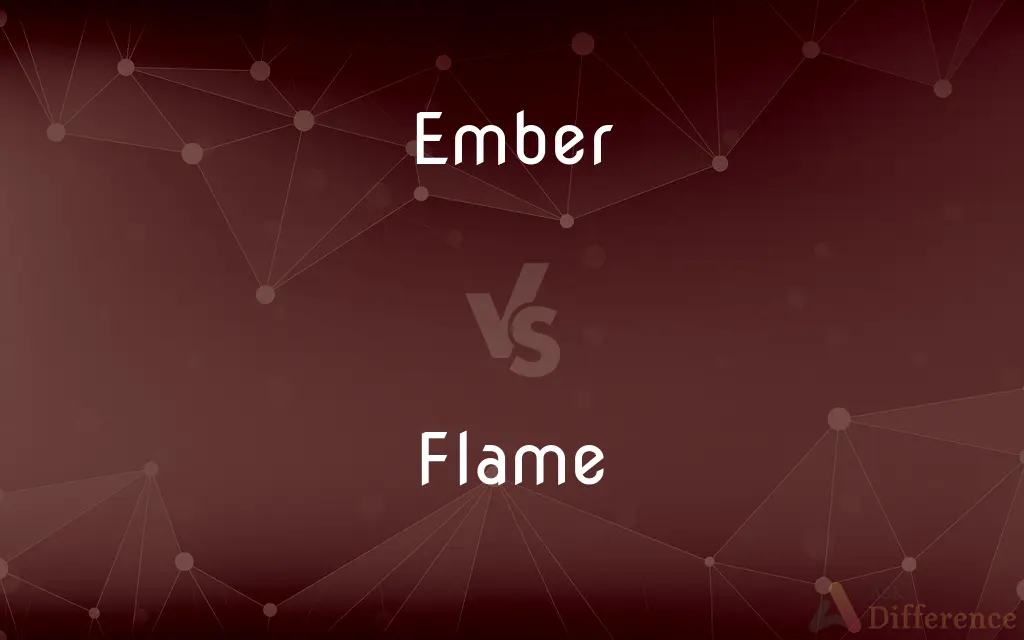Ember vs. Flame — What's the Difference?
By Maham Liaqat & Urooj Arif — Updated on May 9, 2024
An ember is a small, glowing remnant of a fire that has burned down, whereas a flame is the visible, flickering gas component of a fire that actively burns and produces heat.

Difference Between Ember and Flame
Table of Contents
ADVERTISEMENT
Key Differences
An ember is a smoldering piece of coal or wood left after a fire has mostly burned out, retaining heat for a long time. A flame, on the other hand, is the active burning part of a fire, where gases combust and produce visible light.
Embers glow red or orange due to their residual heat and can reignite into flames if given more fuel or oxygen. Flames, meanwhile, are bright, flickering, and usually yellow, orange, or blue, signifying ongoing combustion.
Embers generally remain after the main flames have subsided, providing a slow burn. Flames signify the initial, intense combustion stage, consuming fuel rapidly.
Embers are often used to start new fires or to maintain steady warmth. Flames are essential for quickly igniting materials and creating an immediate source of heat and light.
Embers can burn for hours if well insulated or sheltered from the wind. Flames, however, are more ephemeral and last only as long as there's sufficient fuel and oxygen to sustain combustion.
ADVERTISEMENT
Comparison Chart
Definition
Glowing remnant of a fire
Visible, flickering gas component
Appearance
Red or orange, smoldering
Yellow, orange, or blue, flickering
Combustion Stage
After main combustion
Active combustion
Heat Retention
Long-lasting
Short-term
Fuel Source
Coal or wood remnant
Gas vapors
Compare with Definitions
Ember
The hot remains of a fire that can reignite when disturbed.
They buried the embers to prevent flare-ups.
Flame
A combustion process producing light and heat.
The chef expertly controlled the stove's flame.
Ember
A fragment of coal or wood capable of reigniting a fire.
He used the embers to light the new kindling.
Flame
The visible, gaseous part of a fire.
The flame flickered in the strong wind.
Ember
A metaphor for dormant intensity or energy.
The embers of revolution still smoldered among the people.
Flame
An intense emotional state, often love or passion.
The flame of their friendship never dimmed.
Ember
A small, glowing piece of coal or wood from a dying fire.
The campfire embers glowed in the dark, providing warmth.
Flame
A source of light, such as a torch or candle.
The torch's flame guided their way through the cave.
Ember
A sign of latent potential or remnants of an earlier state.
Her passion still smoldered like embers in her heart.
Flame
To burn intensely or suddenly.
The old letters burst into flame as they touched the fire.
Ember
An ember is a glowing, hot coal made of greatly heated wood, coal, or other carbon-based material that remain after, or sometimes precede, a fire. Embers can glow very hot, sometimes as hot as the fire which created them.
Flame
A flame (from Latin flamma) is the visible, gaseous part of a fire. It is caused by a highly exothermic chemical reaction taking place in a thin zone.
Ember
A small piece of burning or glowing coal or wood in a dying fire
The dying embers in the grate
The flickering embers of nationalism
Flame
The zone of burning gases and fine suspended matter associated with rapid combustion; a hot, glowing mass of burning gas or vapor.
Ember
A small, glowing piece of coal or wood, as in a dying fire.
Flame
The condition of active, blazing combustion
Burst into flame.
Ember
Embers The smoldering coal or ash of a dying fire.
Flame
Something resembling a flame in motion, brilliance, intensity, or shape.
Ember
A glowing piece of coal or wood; a hot coal.
Flame
A violent or intense passion.
Ember
Smoldering ash.
Flame
(Informal) A person that one has an intense passion for.
Ember
Making a circuit of the year or the seasons; recurring in each quarter of the year, as certain religious days set apart for fasting and prayer.
Ember fasts
Ember days
Ember weeks
Flame
(Informal) An insulting criticism or remark meant to incite anger, as on a computer network.
Ember
A lighted coal, smoldering amid ashes; - used chiefly in the plural, to signify mingled coals and ashes; the smoldering remains of a fire.
He takes a lighted ember out of the covered vessel.
Flame
To burn brightly; blaze.
Ember
Making a circuit of the year of the seasons; recurring in each quarter of the year; as, ember fasts.
Flame
To color or flash suddenly
Cheeks that flamed with embarrassment.
Ember
A hot glowing or smouldering fragment of wood or coal left from a fire
Flame
(Informal) To make insulting criticisms or remarks, as on a computer network, to incite anger.
Flame
To burn, ignite, or scorch (something) with a flame.
Flame
(Informal) To insult or criticize provokingly, as on a computer network.
Flame
(Obsolete) To excite; inflame.
Flame
The visible part of fire; a stream of burning vapour or gas, emitting light and heat.
Flame
A romantic partner or lover in a usually short-lived but passionate affair.
Flame
An aggressively insulting criticism or remark.
Flame
(color) A brilliant reddish orange-gold fiery colour. E82D14
Flame
The contrasting light and dark figure seen in wood used for stringed instrument making; the curl.
The cello has a two-piece back with a beautiful narrow flame.
Flame
Burning zeal, passion, imagination, excitement, or anger.
Flame
To produce flames; to burn with a flame or blaze.
Flame
To burst forth like flame; to break out in violence of passion; to be kindled with zeal or ardour.
Flame
To post a destructively critical or abusive message (to somebody).
I flamed him for spamming in my favourite newsgroup.
Flame
Of a brilliant reddish orange-gold colour, like that of a flame.
Flame
A stream of burning vapor or gas, emitting light and heat; darting or streaming fire; a blaze; a fire.
Flame
Burning zeal or passion; elevated and noble enthusiasm; glowing imagination; passionate excitement or anger.
Where flames refin'd in breasts seraphic glow.
Smit with the love of sister arts we came,And met congenial, mingling flame with flame.
Flame
Ardor of affection; the passion of love.
Flame
A person beloved; a sweetheart.
Flame
To burn with a flame or blaze; to burn as gas emitted from bodies in combustion; to blaze.
The main blaze of it is past, but a small thing would make it flame again.
Flame
To burst forth like flame; to break out in violence of passion; to be kindled with zeal or ardor.
He flamed with indignation.
Flame
To kindle; to inflame; to excite.
And flamed with zeal of vengeance inwardly.
Flame
The process of combustion of inflammable materials producing heat and light and (often) smoke;
Fire was one of our ancestors' first discoveries
Flame
Shine with a sudden light;
The night sky flared with the massive bombardment
Flame
Be in flames or aflame;
The sky seemed to flame in the Hawaiian sunset
Flame
Criticize harshly, on the e-mail
Common Curiosities
Can embers turn into flames again?
Yes, embers can reignite into flames if they receive sufficient fuel and oxygen.
What is the main purpose of flames in a fire?
Flames provide immediate heat and light while consuming fuel efficiently.
Are embers hotter than flames?
Embers retain heat longer but are generally cooler than flames at their peak combustion.
Why do embers glow red or orange?
Embers glow due to the hot residual carbon in the coals or wood.
Why do flames flicker?
Flames flicker due to changing airflow, fuel combustion rates, or environmental conditions.
Is it safe to handle embers directly?
No, embers remain extremely hot and can cause burns if touched.
What are "blue" flames?
Blue flames indicate complete combustion with high temperatures and sufficient oxygen.
Can flames exist without embers?
Yes, flames can exist without embers if fuel and combustion conditions are maintained.
Do flames always produce smoke?
Not always; clean combustion with enough oxygen can result in little to no smoke.
How long can embers retain heat?
Embers can stay hot for hours or even days if well-insulated.
What materials produce the best embers?
Hardwood and coal produce long-lasting embers.
Are flames more dangerous than embers?
Flames can spread quickly and are often more immediately hazardous, while embers can ignite secondary fires.
What affects the color of flames?
Flame color is influenced by the temperature and the specific chemicals being burned.
Can flames occur without visible light?
Some flames, like methanol, burn with almost no visible light but still produce heat.
How can embers be safely extinguished?
Embers should be buried or doused with water to ensure they are fully extinguished.
Share Your Discovery

Previous Comparison
Friendship vs. Alliance
Next Comparison
Conference vs. JournalAuthor Spotlight
Written by
Maham LiaqatCo-written by
Urooj ArifUrooj is a skilled content writer at Ask Difference, known for her exceptional ability to simplify complex topics into engaging and informative content. With a passion for research and a flair for clear, concise writing, she consistently delivers articles that resonate with our diverse audience.
















































